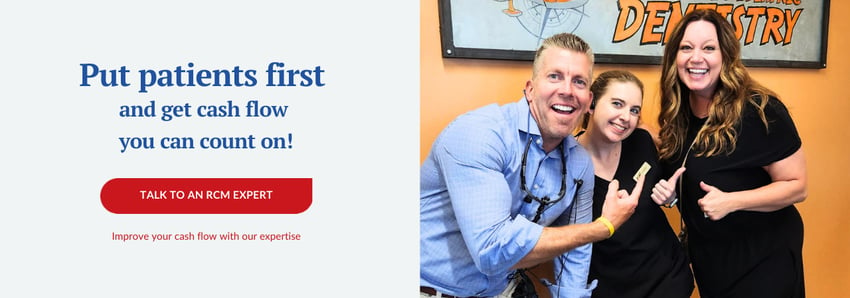6 types of dental insurance plans to know as a dental biller


Too many dentists excel in patient care but quickly become less confident when facing all types of dental insurance plans. A dental insurance coordinator who knows about the different types of dental insurance plans can be a lifesaver in the practice.
It is important to get familiar with the range of dental insurance plans in the marketplace to help communicate with patients and decide which plans to join to run an efficient billing process.
Understanding different types of dental plans is one step to help you determine if you would like to be an in or out-of-network provider.
There’s such a plethora of information on the ever-changing types of dental insurance, that it’s easy to get overwhelmed. Where do you start on your educational journey? What do you need to know as an insurance coordinator or front desk administrator to help your practice and your patients?
Dental ClaimSupport works with a large variety of dental practices that accept all different types of insurance. Each patient and claim is unique, but the goal is all the same: to get insurance payments delivered quickly to your practice and use patient benefits to the max.
In this article, you’ll learn about 6 types of dental insurance plans. When your team understands each type of plan, you will be able to understand the claims process better.
This can help you submit more successful claims and avoid denials in the future. What you’ll learn from this article will also help you determine which kind of insurance you’d like to accept at your practice if you’re looking to make a change.
1. Dental or Medical Preferred Provider Organization (DPPO)
When you are enrolled with PPOs, patients typically have a choice of going to an office within your network or sometimes out of network.
A PPO agreement may have a copay or an out-of-pocket portion for the patient to pay, depending on which plan the patient’s employer provides or the patient has purchased.
When you are in network with PPO insurance, you negotiate your PPO fee schedule. You then enter this schedule into your practice management software database.
PPO plans are a popular choice for dentists because PPO insurance does not assign certain dentists to patients. So, the patient has a wider variety of practices to choose from that will accept their insurance.
An example of dental PPO insurance is Metlife Dental. If this is the patient’s insurance, the network is a list of participating providers around the patient’s area (and beyond) that accept Metlife Dental.
2. Dental Health Maintenance Organization/Capitation (DHMO/CAP)
DHMOs are similar to HMOs. Network doctors are paid a specific fee every month by the carrier even if the patient is not seen at the office. The patient must be enrolled with or assigned to a specific dentist that is a provider on the DHMO or CAP plan to have any coverage.
The dentist receives a roster of patients who are enrolled in the practice along with the monthly insurance Capitation or DHMO payment. Some plans may even send an insurance payment for certain procedures to the practice. Encounter forms are typically required to be submitted, however, some plans will take the standard ADA form.
The provider is sent a monthly capitation payment for each patient that is enrolled with the practice. The provider must verify the patient is actively enrolled in the practice at each visit.
The verification is usually in the insurance portal or the list of enrolled patients that is received with the monthly capitation check. The patient can usually receive dental treatment for a set amount, using only their in-network benefits.
The patient would have a set copay amount that they pay, and the DHMO/CAP may pay at the negotiated portion. The DHMO/CAP in-network provider will usually write off the remaining fee for the procedures. In some cases, the patient may be responsible for the office visit fee, lab fee plus the negotiated patient fee.
These plans can be difficult to manage. If you and your team have a good understanding of each plan you join and put the information properly into your practice management software, it makes it much easier to manage and track if the plan is profitable or a loss.
A DHMO is more limiting than a PPO. The patient will not usually have dental coverage from an out-of-network provider or an in-network provider they have not enrolled with.
This means that the patient goes to a certain in-network provider that they have enrolled with and accepts this insurance plan. An example would be Kaiser Permanente. When patients are covered by Kaiser, they can only typically go to Kaiser locations in order to be covered by their insurance.
Some DHMOs may allow some limited out-of-network coverage if there is a dental emergency and their in-network provider is not available. Beware that an out-of-network emergency provider should always ask if the reimbursement is based on the plan fee schedule or usual customary or reasonable fees.
Most out-of-network providers will collect 100% of the treatment provided and submit to reimburse the patient.
3. Dental discount plans
This is the kind of insurance plan for someone who doesn’t want to pay full fees for their dental treatments, but also doesn’t want to buy insurance coverage.
Some insurance companies will sell discounted insurance plans through a contract with the dentists it is in-network with. You, as the dentist, would then agree to discount your fees for the “covered” patient.
When a patient “covered” by a dental discount plan goes to the dentist, they will only pay a predetermined fee for the treatment provided and an annual membership fee to the insurance company.
You won’t need to file a claim, and there are no waiting periods, maximums, or deductibles. You will want to verify that the patient is still enrolled in the program via the insurance plan portal or a telephone call.
While you are discounting your fee, you are receiving the payment at the date of service. Most practices will bill out the full fee and then post the adjustment to show the patients the savings. Many practices consider the write-off as a marketing expense as they are trying to grow their practice to gain new patients.
The provider is listed on the discount plan website and they can gain new patients from the listing.

4. Direct Reimbursement Plan (DRP)
DRPs are typically funded and easily managed by the patient’s employer and are very cost-effective for the employer. The patient would not be tied to a specific network that allows them to choose any dentist they want.
With a DRP plan, the patient is reimbursed directly for whatever they spend on their dental work. DRP plans differ between each patient’s employer. Some employers will reimburse patients themselves, and some will simply pay you (the dentist) directly.
So, no matter what, you are getting your full fee from the patient’s employer.
Cosmetic dentistry is covered, pre-authorization is not required for DRPs, and there are no deductibles or premiums for the patient.
There is typically an annual allowance or maximum that is a “use it or lose it” This is by far the best plan for the patient and you: the provider.
5. Indemnity Plans/Traditional
Indemnity plans are also known as “traditional insurance” The plan usually pays a percentage of the UCR (Usual Customary Reasonable) fee. There may be a waiting period, deductible, maximum amount and other limitations to be verified in the insurance portal, telephone, or fax.
In some indemnity plans, you, as the dentist, would be paid directly by the insurance after the patient has assigned his or her benefits to the plan. In some plans, there is no assignment of benefits and the patient is paid. The patient can usually choose any doctor they want. However, some indemnity plans are in network with a PPO.
Most indemnity plans cover preventive and diagnostic at 100% of the UCR, basic dentistry at 80%, and major at 50%. This will include a deductible applied at the basic and major level and a max allowance base on a benefit or calendar year.
Each plan is unique and the details should be entered into your practice management software. Point of service plans are also referred to as half PPO, and half DHMO plans.
Patients (or whoever has purchased the coverage) can choose to be in-network with a dentist as their primary dental provider. But the insured can also choose to go out of network for other dental services. If that is the case, the patient would pay the full fee for the dental services.
There are cases in which the patient’s primary dentist could refer the patient to a specialist that is out of network. And if this is the case - the patient might not have to pay the full fee since it was a referral from their in-network dentist.
Point of service plans can be limiting as far as choosing a dental provider goes, but the cost is lower for the patient.
6. Exclusive Provider Organizations (EPO)
EPO plans have a network of participating dentists that patients can choose from. As the dentist, you would agree to accept reduced fees or negotiated fees from patients with EPO plans.
Patients cannot choose dental providers outside of this network without paying their full dental service fees. It’s like a PPO plan, but with fewer options, and a much lower premium for patients.
Like PPOs, EPO plans cover preventative treatment, emergencies, and specialist treatment such as surgery. But this is only if the patients are seeing their in-network dental provider.
Ready to dive deeper into dental insurance education?
As a dentist and/or business owner, it’s up to you to decide which plans to join as a provider and which credentialing process you want to take on.
And you shouldn’t blindly go into the process of joining a provider network. You now understand 7 common dental insurance plan types to help you decide what types of plans will work best with your practice.
Dental insurance is complicated, which is why Dental ClaimSupport created the educational platform Dental Claims Academy. Keeping up with information such as insurance plans, and how their claim process might affect your team is crucial for quick reimbursement. Check out the course on PPO claims administration.
Earn CE credits and keep learning about dental insurance billing to bring valuable dental billing skills that your practice needs to thrive.
Related Posts
Dental revenue resources from Dental Cashflow Solutions (formerly Dental Claim Support)


